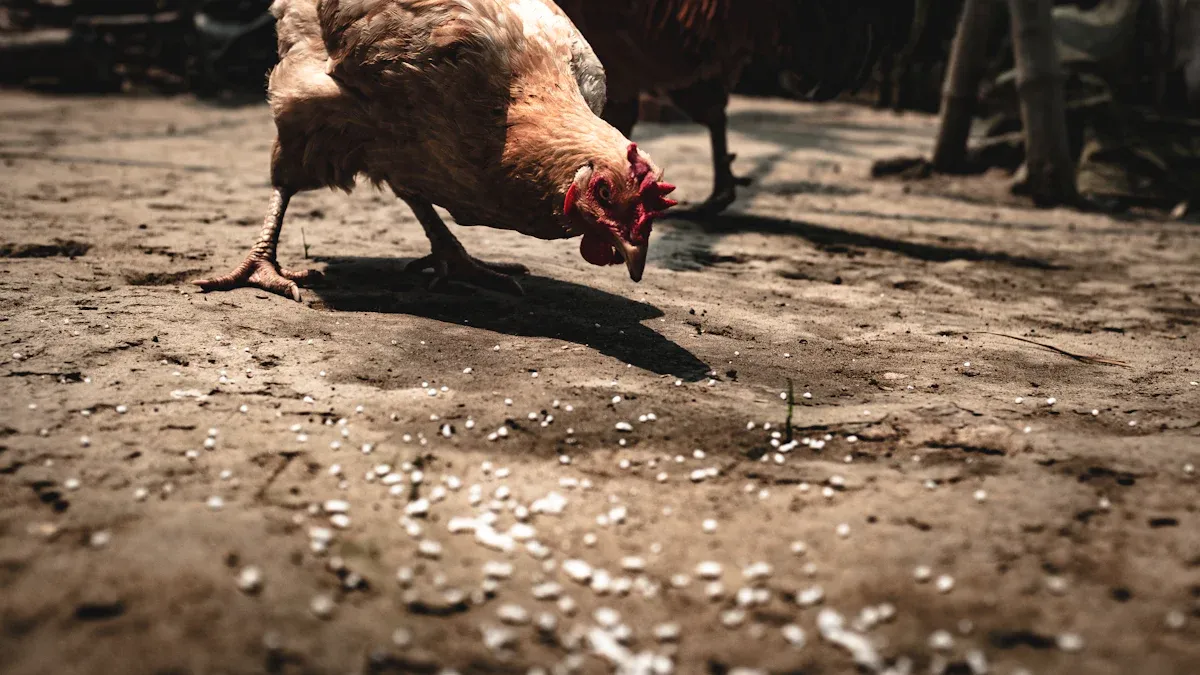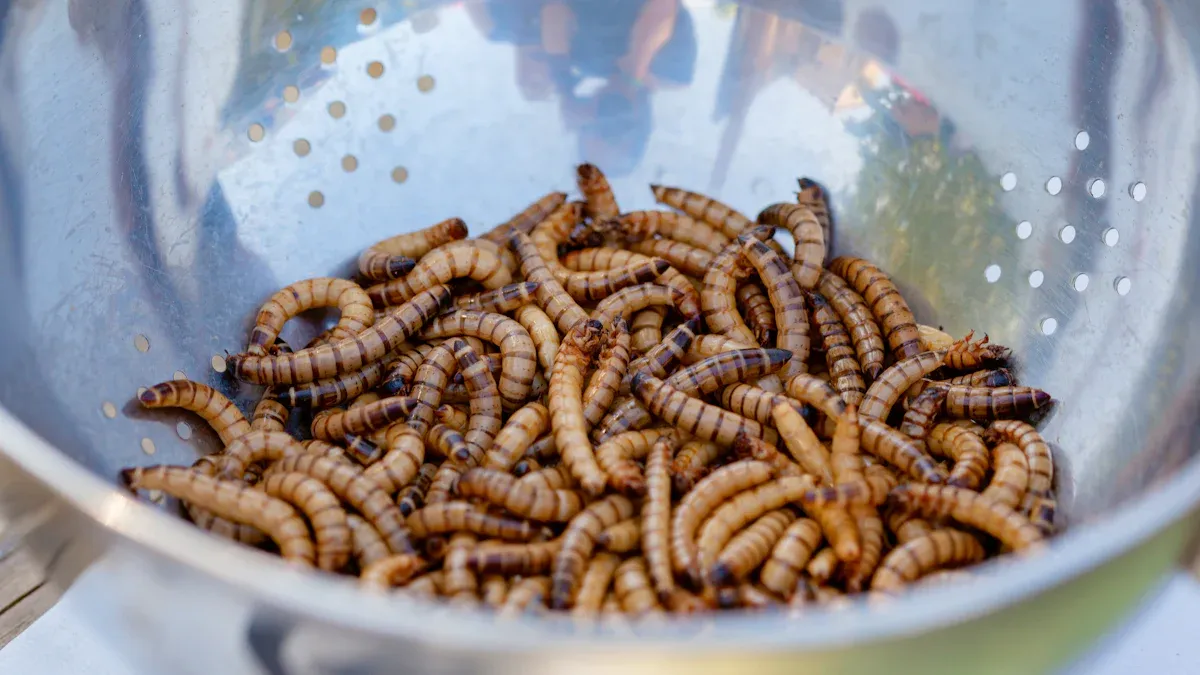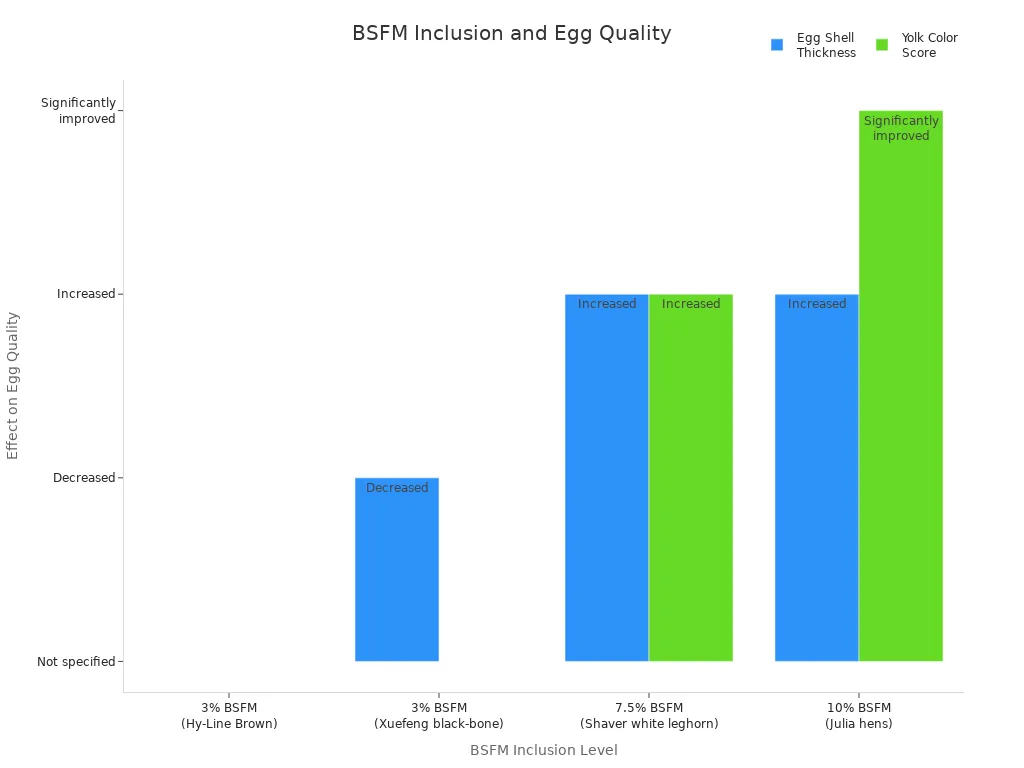
Mealworms in Poultry Feeding deliver a powerful protein boost. The protein content in mealworm meal reaches up to 59%, surpassing soybean meal. Chickens thrive on this concentrated nutrition.
| Protein Source | Crude Protein Content (%) |
|---|---|
| Mealworm Meal | 25 – 60 |
| Soybean Meal | ~44 |
| Fishmeal | Comparable or less |
Key Takeaways
- Mealworms provide poultry with high protein, essential amino acids, vitamins, minerals, and healthy fats that support strong growth, healthy feathers, and better egg quality.
- Feeding mealworms improves chickens’ natural behaviors, boosts their immune system, reduces stress, and leads to healthier, more active birds.
- Introduce mealworms gradually as a treat up to 10% of the diet, choose quality sources, and store them properly to ensure safe, effective, and sustainable poultry nutrition.
Nutritional Value of Mealworms in Poultry Feeding

High Protein and Amino Acids
Mealworms in Poultry Feeding deliver a powerful protein punch. Their crude protein content ranges from 27% to 54%, with many studies showing values above 46%. This level surpasses soybean meal and matches fish meal, making mealworms a top choice for poultry nutrition. The amino acid profile stands out as well. Mealworms provide essential amino acids like lysine, methionine, and tryptophan in amounts that meet or exceed poultry dietary needs. These nutrients support muscle growth, feather development, and overall health.
Poultry fed with mealworms receive a balanced supply of amino acids, which helps them grow stronger and healthier.
| Essential Amino Acid | Present in Mealworms | Meets Poultry Needs |
|---|---|---|
| Lysine | Yes | Yes |
| Methionine | Yes | Yes |
| Threonine | Yes | Yes |
| Tryptophan | Yes | Yes |
Essential Vitamins, Minerals, and Healthy Fats
Mealworms in Poultry Feeding offer more than just protein. They contain vital vitamins such as B12 and other B vitamins, which support nerve function and energy metabolism. Important minerals like calcium, phosphorus, iron, and zinc help build strong bones, support blood health, and boost the immune system. Mealworms also provide healthy fats, including oleic and linoleic acids. These fats give chickens steady energy, promote glossy feathers, and improve egg quality by increasing healthy fatty acids in yolks.
- Rich in B vitamins for energy and nerve health
- High in calcium and phosphorus for bone strength
- Packed with healthy fats for energy and feather shine
Nutrient Density for Growth and Reproduction
Mealworms in Poultry Feeding stand out for their nutrient density. Dried mealworms can contain up to 50% protein and up to 40% healthy fats. This dense nutrition supports rapid growth, strong feather regrowth during molting, and improved egg production. The combination of protein, amino acids, vitamins, minerals, and fats makes mealworms an ideal supplement for both young and adult birds. Poultry owners who add mealworms to their birds’ diets often see better growth rates, healthier feathers, and more robust egg production.
Benefits of Mealworms in Poultry Feeding
Enhanced Growth and Feather Development
Mealworms in Poultry Feeding help chickens grow faster and stronger. Their high protein and amino acid content supports muscle development and healthy feathers. Many studies show that chickens and quail fed mealworm meal gain more weight and have better feed conversion ratios than those on standard diets.
- Biasato et al. (2017) found that chickens eating Tenebrio molitor meal gained more weight than those on regular feed.
- Elahi et al. (2020) reported that dried mealworm meal increased body weight in young poultry.
- Adding 3 g/kg of mealworm scales to Japanese quail diets led to higher weight gain and better carcass traits.
- Replacing part of soybean meal with mealworm meal improved growth and feed use in broilers.
- Mealworms provide protein, fats, amino acids, and minerals that support gut health and may even replace antibiotics.
Chickens with access to mealworms often show brighter, fuller feathers, especially during molting. This makes mealworms a smart choice for poultry owners who want healthy, attractive birds.
Improved Egg Production and Quality
Mealworms in Poultry Feeding boost egg production and improve egg quality. Hens that eat mealworms lay more eggs, and the eggs are larger with stronger shells and richer yolks. Research shows that adding natural dried mealworms to a hen’s diet increases egg size, shell strength, and yolk color. Mealworms supply protein, calcium, and phosphorus, which are vital for strong eggshells and healthy hens.
A scientific study found that supplementing laying hens’ diets with insect meal at 3% and 5% levels increased egg weight and improved feed conversion. Hens eating mealworms also produced eggs with better flavor and higher nutritional value, including more omega-3 fatty acids.
The following table shows how insect meal affects egg quality:
| Inclusion Level of BSFM | Egg Shell Thickness | Yolk Color Score | Other Egg Quality Effects |
|---|---|---|---|
| 3% BSFM (Hy-Line Brown) | Improved growth performance; shell thickness not specified | Not specified | Improved digestibility, immune parameters |
| 3% BSFM (Xuefeng black-bone hens) | Decreased shell thickness | Not specified | Increased egg weight, shell weight, amino acids |
| 5% BSFM | Not specified | Not specified | Improved egg production, feed efficiency |
| 7.5% BSFM (Shaver white leghorn) | Increased shell thickness | Increased yolk color score | Increased feed intake, body weight |
| 10% BSFM (Julia hens) | Increased shell thickness | Significantly improved yolk color score | Increased egg weight, albumin height, plasma calcium |
| 15% BSFM (Lohman brown classic) | Not specified | Not specified | Improved egg weight, egg mass, metabolizability |
| 17% BSFM | Not specified | Not specified | Poor growth, decreased production, altered blood parameters |
| 24% BSFM | Not specified | Not specified | Increased fecal dry matter |

Mealworms help hens lay eggs that are not only more plentiful but also healthier and more appealing.
Boosted Immunity and Stress Reduction
Mealworms in Poultry Feeding strengthen the immune system and help birds handle stress. Chickens that eat mealworms show better disease resistance and healthier guts. Scientific studies reveal that mealworm supplementation lowers harmful bacteria like E. coli and Salmonella in the gut. The chitin in mealworm shells supports good gut bacteria and boosts antibody levels.
- Broilers fed yellow mealworm or super mealworm show stronger immune traits and better growth.
- Mealworms reduce harmful bacteria and increase beneficial bacteria in the gut.
- Chitin in mealworms helps the immune system by supporting healthy gut microbes.
- Insect meals improve the balance of gut bacteria, which protects birds from disease.
Mealworms also help chickens cope with stress from molting, extreme weather, or changes in their environment. Birds that eat mealworms often appear calmer and more active, showing fewer signs of stress.
Promotion of Natural Foraging Behaviors
Mealworms in Poultry Feeding encourage chickens to act naturally. When chickens receive mealworms, they spend more time pecking, scratching, and searching for food. These behaviors keep birds active and happy, reducing boredom and frustration.
| Behavior Observed | Effect of Live Mealworms (YM) and Other Insect Larvae (BSF) | Comparison to Other Enrichments | Behavioral Implication / Interpretation |
|---|---|---|---|
| Ground Pecking | Increased time during larvae intake (morning) | Higher than non-supplemented birds | Indicates stimulation of natural foraging behavior |
| Scratching | Increased frequency during larvae intake | More than non-supplemented birds | Key component of natural foraging behavior |
| Stretching | Increased frequency in morning (decreased during larvae intake) | Not observed with other enrichments | Reflects increased activity and welfare |
| Wing Flapping | Increased frequency, especially in YM-fed birds | Not stimulated by other enrichments | Sign of increased activity and positive welfare |
| Walking | Increased time spent walking | Not matched by other enrichments | Indicates higher activity levels |
| Laying Down | Increased duration in afternoon for BSF and YM groups | Not reported with other enrichments | Possibly related to post-foraging rest |
| Preening | Reduced frequency and duration | Higher preening linked to boredom/frustration in non-enriched birds | Suggests reduced boredom/frustration due to larvae enrichment |
Studies show that chickens fed live mealworms become more active and spend less time standing still. They walk, scratch, and peck more, which improves their physical and mental health. Mealworms provide a fun and healthy way to enrich a chicken’s daily life.
Tip: Offering mealworms as a treat or supplement can transform your flock’s environment, making birds more engaged and content.
Practical Feeding and Safety Considerations

How to Feed Mealworms Safely
Poultry owners can safely introduce mealworms by following a few simple steps:
- Start with a small amount, making up about 2-5% of the total diet.
- Gradually increase the amount to help birds adapt.
- Offer mealworms by hand, scatter them in the run, or mix them with regular feed to encourage foraging.
- Always monitor for freshness and avoid moldy or spoiled mealworms.
Veterinary guidelines confirm that low inclusion rates support gut health and prevent harmful bacteria. Proper storage and gradual introduction keep poultry safe and healthy.
Recommended Quantities and Frequency
Mealworms are rich in protein, so only a small amount is needed. For most chickens, 1 to 10 mealworms per day or up to 2 tablespoons per bird is enough. Treats like mealworms should not exceed 10% of the daily diet. Owners should offer mealworms as an occasional treat, not as the main feed.
Sourcing, Storage, and Quality Tips
Choose high-quality mealworms from trusted suppliers. Look for mealworms raised on clean, nutritious feed. Store dried mealworms in airtight containers in a cool, dry place. For live mealworms, use ventilated containers with fresh bedding and vegetables for moisture. Remove uneaten food daily to prevent mold.
Tip: Picky Neb mealworms are farmed under strict standards and fed only non-GMO, organic feed, ensuring top quality for poultry.
Safety, Hygiene, and Moderation
Safe feeding means keeping mealworm portions moderate. Studies show that 1% to 7.5% inclusion improves growth, immunity, and egg quality. Higher levels may upset gut balance. Always check for spoilage and keep feeding areas clean.
| Inclusion Level | Benefits for Poultry |
|---|---|
| 1% – 7.5% | Better growth, immunity, eggs |
| 10% – 15% | Use with caution |
Sustainability and Cost-Effectiveness
Mealworms in Poultry Feeding offer a sustainable protein source. They require less land and water than traditional livestock. Mealworms convert feed efficiently and can be raised on food by-products, lowering costs and environmental impact. Both backyard and commercial poultry keepers benefit from their cost-effectiveness and nutritional value.
- Mealworms give poultry a strong boost in nutrition and health.
- Research shows they improve growth, egg quality, and natural behaviors.
- Experts recommend mealworms as a safe, sustainable supplement.
- Poultry owners see better productivity and happier birds when adding mealworms to the diet.
FAQ
Are mealworms safe for all types of poultry?
Yes. Chickens, ducks, quail, and turkeys can all enjoy mealworms. Owners should always introduce mealworms slowly and watch for any unusual reactions.
How often should poultry eat mealworms?
Poultry benefit most from mealworms as a treat two to three times per week. Owners should keep treats under 10% of the total diet for best results.
Why choose Picky Neb mealworms for poultry?
Picky Neb mealworms deliver premium nutrition. They come from organic, non-GMO feed. Birds thrive with stronger growth, better eggs, and more natural behaviors. Choose Picky Neb for healthier flocks!


